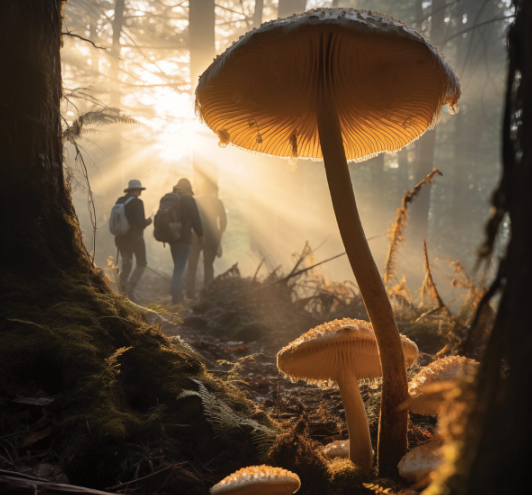Published in Perspective
December 2023
My first encounter with mushroom culture happened outside St Petersburg, where I stayed as a teenager with a Russian exchange family. They lived a modern, urban life in a cramped apartment block, but one weekend we left the city to visit their grandparents’ dacha. On arrival in the village the family immediately changed their clothes, swapping shell suits and trainers for antiquated peasant gear, complete with knee-high leather boots and Soviet-style workers’ caps. Armed with knives and baskets they disappeared into the woods, and the rest of the weekend was devoted to mushroom gathering. They must have collected hundreds of them – ranging from the vaguely familiar to the slimily uncanny – to be dried and stored in jars to see the family through the winter. I was struck by the transformation this fungal connection had brought about; it seemed that we had collectively slipped into Russia’s peasant past.
Another memorable mushroom encounter came years later in Romania, where I stopped my hired car on a steep mountain road. Two Roma children, a brother and sister, had flagged me down for a lift, each carrying an enormous, pungent wicker basket. As I drove them up the mountain, the car filled with the rich scent of cep, which, I managed to learn, were eventually bound for Italy, where they would fetch high prices in hotels and restaurants. When we reached their stop my passengers slipped back into the forest, but the smell stayed in the car for days – an olfactory reminder of an ancient foraging culture.
In Russia, Eastern Europe, the Balkans, the Baltics and Scandinavia, as across the northern hemisphere all the way to Japan, there exists a powerful cultural affinity with mushrooms. Autumn is gathering season, when the fruiting bodies of underground mycelium – the network of hyphae or fungal threads that is sometimes called the ‘wood wide web’ – thrust themselves into the light to unleash their clouds of spores, and humans descend upon the forests, harvesting knives in hand. Here in Britain, despite a recent resurgence of interest in foraging, there is no equivalent seasonal exodus to the woods, though there surely was in the pre-industrial past. Our peasant connection to the land and wild food was broken a long time ago, along with a rich heritage of plant- and fungus-lore. The knowledge of what’s edible, what’s medicinal and what’s poisonous has given way to a suspicion – even a fear – of fungal forms. Merlin Sheldrake’s book Entangled Life and Anna Tsing’s The Mushroom at the End of the World, as well as Björk’s 2022 album, Fossora, might have brought fungus to new audiences, but many still look at anything slipperier than a portobello with misgivings and a shudder of revulsion.
I am a poor forager – my Russian hosts would be unimpressed – but I have spent many hours searching the woods this autumn. We tell ourselves that at this time of year everything starts to die as leaves fall, grass flattens and colours fade to brown. But autumn is to mushrooms what spring is to flowering plants. It is not a time of death, just the birth of a different life. As Flora and Fauna hunker down to wait out the damp and dark, a third kingdom – Funga – comes into its own.
*
The woods are a mile from my house, spread out on both banks of a stream in a valley whose quarried walls reveal the scars of industry. A combination of steep slopes, poor soil and rainfall have loosened the roots of many trees, which regularly fall across the path. Their decomposing trunks make perfect habitats for mushrooms. It requires a conscious focus-shift to spot the first fruiting forms, a slowing down and zooming in, but soon I see them everywhere. These are my first attempts at identification:
Clusters of turkey tail, rippled in yellows, tans and browns (edible though leathery). Coal fungus, which also goes by the name King Alfred’s cake (inedible but makes good kindling when dried). Bracket fungus, like fan-shaped shelves bolted to the trunks of oaks (inedible). Dead man’s fingers, which look like something trying to escape a grave (inedible and likely cursed). Frosty bonnets like ghostly parachutes, their caps mere millimetres wide (edibility unknown according to my ID guide, but, in any case, too miniscule to bother with). An eruption of honey fungus, golden and slightly toasted-looking, cascading from a rotting tree (edible and delicious to some, unpalatable to others). And in a field nearby grow giant puffballs and horse mushrooms (fried in garlic and butter, these are the best I have ever tasted).
What connects these weird and wonderful denizens of the earth, and the many, many others my eyes are not yet trained to see, is the collective work they do: the great recycling. Fungi break down organic matter to release essential nutrients that create new forms of life. Without this transformation, dead things would not decompose and the world would be buried under sediment that never disappeared. The fungal kingdom has been described as the interface between life and death. We think of mushrooms as things to eat, but they – or their mycelium – are doing most of the eating.
*
‘Working with mushrooms, I provide what they need, and they provide what I need. It’s a collaboration.’ A few miles from the woods, on the ground floor of an ex-council building, a mushroom-grower called Antony Potts shows me around his farm. The process starts with the introduction of spores to a liquid culture of sugar syrup, extracting the mycelium and introducing that to sterilised grain, and then moving the resulting spawn into blocks of oak sawdust. The gourmet species that fruit from there are lion’s mane, shiitake and oyster, which are sold to Bristol greengrocers and restaurants.
All this takes place within the tiled walls of a decommissioned toilet block, which explains the name: Flushrooms. Some might be queasy at the association of toilets and food, but, as Antony points out, it’s a perfect sterile space, designed to be easily cleanable with water and extraction. There are even storage shelves built into an old cubicle. And the cultivation of mushrooms here works on a symbolic level, too, because ‘fungi are the natural recyclers of the planet, so it made sense to find a disused space and repurpose it.’
Every stage of the growing process involves recycling. The mycelium grows in waste products – sawdust from the furniture industry, discarded wheat bran and soya hulls – and once the mushrooms are harvested the oak blocks they colonised are donated to allotments, where they make rich compost. ‘I like to think that I’m gradually seeding Bristol with mycelium. It’s going to make a difference in some small way.’
At first glance this immaculate space, with mushrooms grown in still-air tents that filter out microbes and moulds, seems to belong in a different world from the fruiting free-for-all outside. But despite what seem like stable conditions, where inputs and outputs can be controlled, Antony notes that achieving consistent yields is challenging. The building is not immune from seasonal temperature fluctuations, and over the years he has learned to switch varieties through the year: king and pink oysters fruit better in summer, and blue and elm oysters in winter. The separation of inside and outside is illusory; despite all the sterilisation, Flushrooms is still very much an engagement with a natural process.
*
I am back in the woods to spend more time with Flushrooms’ wild relatives. My eyes have become mushroomised, and every trunk, living or decomposing, seems to bloom with colonies. Life and death, growth and decay, consuming and being consumed – these are not opposite states but points on a continuum, and fungi is the intermediary by which one becomes the other. Beneath my feet mycelium spreads in intricate networks I can’t see – the hidden pattern that gives rise to mushroom culture.
One of Antony’s stated aims is to combat British fear of fungi. In that spirit – and with my Russian and Romanian friends in mind – I return to the honey fungus and carefully start harvesting. I take only what I need and leave the rest to their work. Even agents of life and death taste great with garlic and butter.


